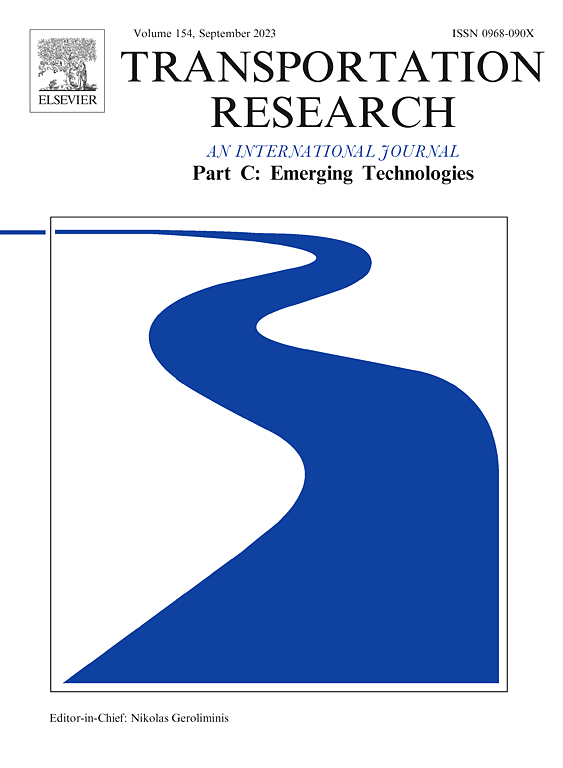Integrated optimization of demand-oriented timetabling and rolling stock circulation planning with flexible train compositions and multiple service routes on urban rail lines
IF 7.6
1区 工程技术
Q1 TRANSPORTATION SCIENCE & TECHNOLOGY
Transportation Research Part C-Emerging Technologies
Pub Date : 2025-03-10
DOI:10.1016/j.trc.2025.105071
引用次数: 0
Abstract
This study investigates an integrated train operation plan problem with flexible train compositions and multiple service routes, which allows trains to couple, decouple and turn around at intermediate turnaround stations based on virtual coupling technology. An integrated optimization model for demand-oriented train timetables and rolling stock circulation plans is developed with the consideration of train service routes and the number of train services, by minimizing both passenger waiting time and operation costs. Specifically, with the path-based space–time network representation, we formulate a novel rolling stock circulation model, which accounts for coupling and decoupling operations and stabling track capacity constraints with lower complexity than the assignment model. In addition, we improve the linear dynamic passenger flow loading model, which extends the operational application with multiple service routes and characterizes various passenger waiting behaviors. To solve the proposed model, an adaptive simulated annealing (ASA) algorithm is designed to obtain high-quality solutions using flow-oriented and random operators. Lastly, the performance of the proposed models and algorithms is verified by small-scale numerical experiments. Then, the efficiency of the proposed approaches is further demonstrated through a real-world case study based on Beijing Subway Changping Line, showing a 42% reduction in total passenger waiting time, a decrease of 16 rolling stock, and a 10% reduction in variable operation costs compared to the current operation mode.
以需求为导向、列车组成灵活、服务路线多样的城市轨道交通调度与车辆流通规划集成优化
本文研究了基于虚拟耦合技术的列车组合灵活、服务路线多的列车综合运行计划问题,该问题允许列车在中间枢纽站进行耦合、解耦和返航。在考虑列车服务路线和列车服务班次的情况下,以最小化乘客等待时间和运营成本为目标,建立了以需求为导向的列车时刻表和车辆流通计划的综合优化模型。具体而言,我们利用基于路径的时空网络表示,建立了一种新的车辆流通模型,该模型考虑了耦合和解耦操作,并且稳定了轨道容量约束,其复杂性低于分配模型。此外,我们改进了线性动态客流加载模型,扩展了多服务路线的业务应用,并表征了乘客的各种等待行为。为了求解该模型,设计了一种自适应模拟退火(ASA)算法,利用面向流和随机算子获得高质量的解。最后,通过小尺度数值实验验证了模型和算法的有效性。然后,通过北京地铁昌平线的实际案例研究,进一步证明了所提出方法的有效性,与现有运营模式相比,总乘客等待时间减少了42%,减少了16辆机车车辆,可变运营成本降低了10%。
本文章由计算机程序翻译,如有差异,请以英文原文为准。
求助全文
约1分钟内获得全文
求助全文
来源期刊
CiteScore
15.80
自引率
12.00%
发文量
332
审稿时长
64 days
期刊介绍:
Transportation Research: Part C (TR_C) is dedicated to showcasing high-quality, scholarly research that delves into the development, applications, and implications of transportation systems and emerging technologies. Our focus lies not solely on individual technologies, but rather on their broader implications for the planning, design, operation, control, maintenance, and rehabilitation of transportation systems, services, and components. In essence, the intellectual core of the journal revolves around the transportation aspect rather than the technology itself. We actively encourage the integration of quantitative methods from diverse fields such as operations research, control systems, complex networks, computer science, and artificial intelligence. Join us in exploring the intersection of transportation systems and emerging technologies to drive innovation and progress in the field.

 求助内容:
求助内容: 应助结果提醒方式:
应助结果提醒方式:


